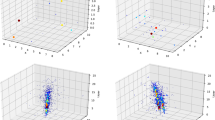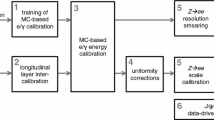Abstract
Background
The lead-scintillating fiber electromagnetic calorimeter (ECAL) of the Alpha Magnetic Spectrometer measures the energy of positrons/electrons and separates them from hadrons. The electromagnetic shower shapes from Monte Carlo (MC) simulation and data show disagreement.
Purpose
Tuning the MC to make the shower shapes from MC and data agree with each other.
Methods
The tuning is based on a 3D electromagnetic shower model.
Results
After tuning, the electromagnetic shower shapes are well described by MC up to TeV. As a result, the output of ECAL electron/proton separation estimator, ECAL BDT, shows that MC and data are in good agreement. The proton rejection power of the ECAL BDT trained with MC electron samples is improved by a factor of 5 at \(\sim \,800\,\hbox {GeV}\) compared to the one trained with data.







Similar content being viewed by others
References
S. Ting, The alpha magnetic spectrometer on the international space station. Nucl. Phys. B Proc. Suppl. 243–244, 12–24 (2013)
S. Agostinelli et al., GEANT4-a simulation toolkit. Nucl. Instrum. Methods Phys. Res. A 506, 250–303 (2003)
J. Allison et al., Recent developments in GEANT4. Nucl. Instrum. Methods Phys. Res. A 835, 186–225 (2016)
M. Aguilar et al., First result from the alpha magnetic spectrometer on the international space station: precision measurement of the positron fraction in primary cosmic rays of 0.5–350 GeV. Phys. Rev. Lett. 110, 141102 (2013)
A. Kounine et al., Precision measurement of 0.5 GeV–3 TeV electrons and positrons using the AMS electromagnetic calorimeter. Nucl. Instrum. Methods Phys. Res. A 869, 110–117 (2017)
L. Accardo et al., High statistics measurement of the positron fraction in primary cosmic rays of 0.5–500 GeV with the Alpha Magnetic Spectrometer on the International Space Station. Phys. Rev. Lett. 113, 121101 (2014)
M. Aguilar et al., Electron and positron fluxes in primary cosmic rays measured with the alpha magnetic spectrometer on the international space station. Phys. Rev. Lett. 113, 121102 (2014)
M. Aguilar et al., Precision measurement of the \((e^++e^-)\) flux in primary cosmic rays from 0.5 GeV to 1 TeV with the Alpha Magnetic Spectrometer on the International Space Station. Phys. Rev. Lett. 113, 221102 (2014)
C. Adloff et al., The AMS-02 lead-scintillating fibers electromagnetic calorimeter. Nucl. Instrum. Methods Phys. Res. A 714, 147–154 (2013)
Z. Li et al., Correction of PMT position effect for a lead-scintillating fiber electromagnetic calorimeter. Chin. Phys. C 37(02), 026201 (2013)
Z. Li et al., Angular reconstruction of a lead scintillating-fiber sandwiched electromagnetic calorimeter. Chin. Phys. C 38(05), 056203 (2014)
C. Zhang et al., Dead cell and side leakage correction for a lead-scintillating fiber electromagnetic calorimeter. Chin. Phys. C 40(09), 096204 (2016)
E. Longo, I. Sestili, Monte Carlo calculation of photon-initiated electromagnetic showers in lead glass. Nucl. Instrum. Methods 128, 283–307 (1975)
G. Grindhammer, S. Peters, The parameterized simulation of electromagnetic showers in homogeneous and sampling calorimeters (2000). arXiv:hep-ex/0001020
S. Zhang et al., Improvements on the particle identification with dead cell and side leakage corrections for the electromagnetic calorimeter of the Alpha Magnetic Spectrometer. Radiat. Detect. Technol. Methods 2, 33 (2018)
M. Aguilar et al., Towards understanding the origin of cosmic-ray positrons. Phys. Rev. Lett. 122, 041102 (2019)
Acknowledgements
We thank Dr. Weiwei Xu for useful discussions on the 3D shower model.
Author information
Authors and Affiliations
Corresponding author
Additional information
Supported by National Natural Science Foundation of China (11220101004), the UCAS Joint Ph.D. Training Program and the China Scholarship Council.
Rights and permissions
About this article
Cite this article
Wang, XQ., Li, ZH., Tang, ZC. et al. Improvement in the 3D shower shapes description in the Monte Carlo simulation for a lead-scintillating fiber electromagnetic calorimeter. Radiat Detect Technol Methods 3, 34 (2019). https://doi.org/10.1007/s41605-019-0113-3
Received:
Revised:
Accepted:
Published:
DOI: https://doi.org/10.1007/s41605-019-0113-3




